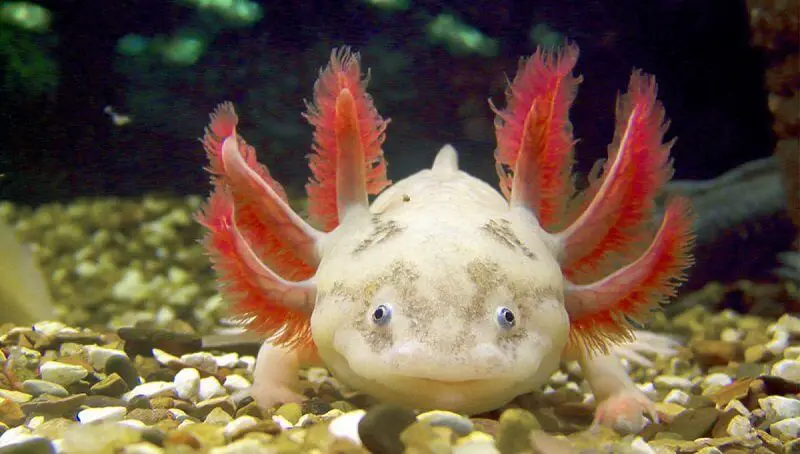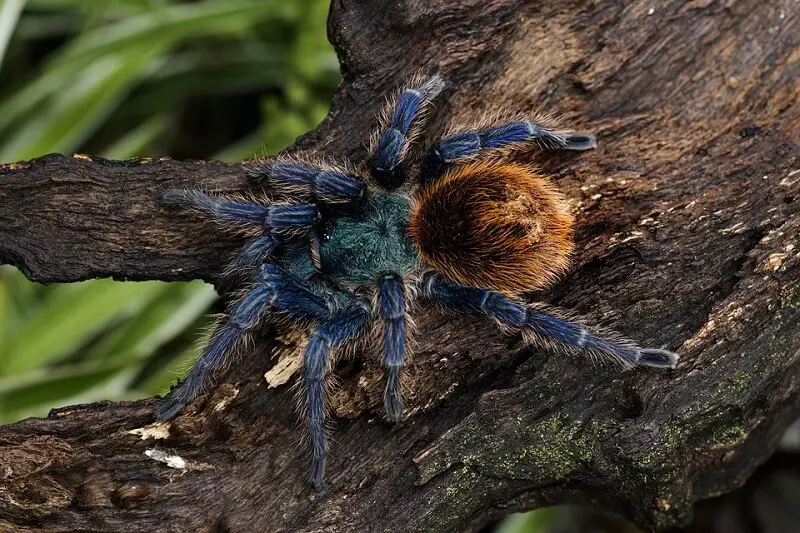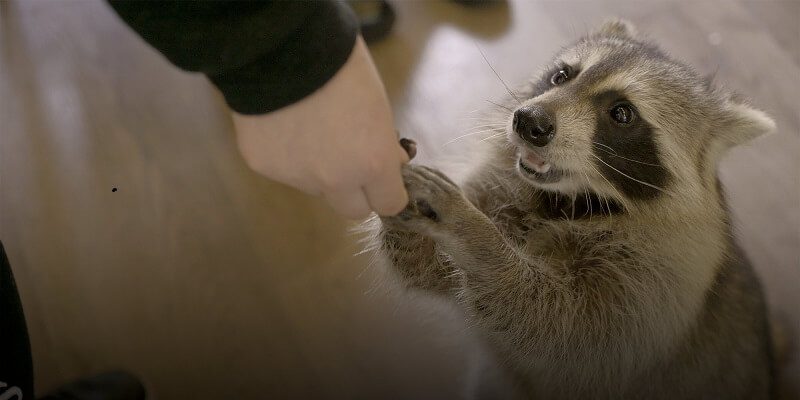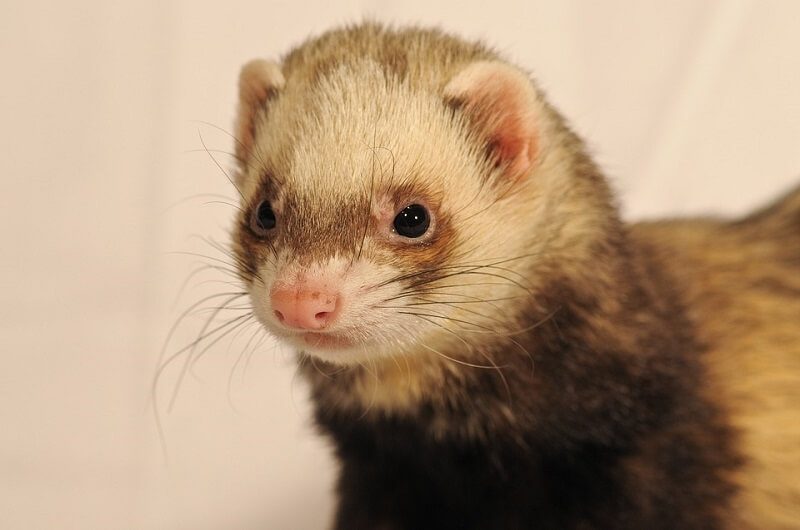Axolotl’s Origin
Axolotl salamander is also known as the Mexican salamander or the Mexican Walking Fish. It is a neotenic fish because it has the capacity to reach sexual maturity and to reproduce at the larva stage. It is related to the tiger salamander.
Although the Axolotl salamander is known as the walking fish this is not a fish, but an amphibian.
If the vast majority of axolotl specimens live in captivity, in the wild this species is gray/black and is seriously threatened by extinction. Its only natural habitat is Xochimilco, a lake in the southern capital of Mexico. It is the best known Neotenic Mexican Salamander belonging to the group of brindle salamanders of the Ambystomatidae family.
Although among the strangest species of salamanders, it is the symbol of Mexico. Usually, these salamanders are grown in aquariums as decorative fish, especially in the United States, the United Kingdom, Australia, and Japan, where they are sold under the name of wooper looper).
White with dark eyes, as the domestic version, this Mexican salamander has fascinated biologists, for a long time, thanks to its exceptional physical capabilities. Axolotl is able to regenerate parts of its body such as eyes, spinal cord, or feet. Hence the particular interest of scientists and research laboratories in this animal.
In 2016, researchers from North University in the United States studied, for example, this animal’s ability to reconstruct its ovaries to fight infertility.
Another talent of this aquatic monster is its ability to stay in a state of larvae. Very rarely it gets to an adult state, and therefore it is predominantly like a tadpole. It is a less known biological phenomenon called neoteny.
According to a census conducted in 2014 by the National Autonomous University of Mexico, the density of axolotl in Xochimilco Lake was only 0,3 specimens per square kilometer, compared to 1.000 in 1996.
In 2006, the International Union for Nature Conservation (IUCN) decided that this animal is in critical danger of extinction.
The number of representers of the Ambystoma mexicanum has fallen drastically due to the intensification of the state of Mexico’s urbanization process and, consequently, water pollution.
The reason for its disappearance? Poor quality water, polluted by pesticides and waste, and the introduction of fish that alter the lake’s ecosystem balance.
Projects to preserve the habitat for Axolotl are currently in work and local farmers are being urged to give up pesticides.
Temper
Active, it is not aggressive, but it has cannibalistic tendencies and therefore specimens must be hosted individually or in small groups.
Characteristics and description
The body length of an Axolotl can be anywhere from 6 to 18 inches long from the head to the tail tip, though over 12 inches is pretty rare. Most often, males have a larger body than females have.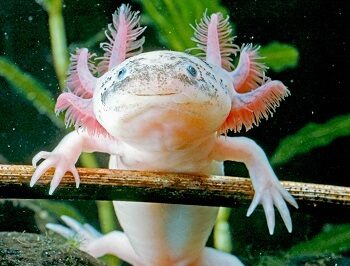
Ambystoma come in two forms. The first is a neoteric larvae with external gills, which can only be found in water. The second form is the adult form and it is terrestrial. These lizards grow much faster than other neotenic larvae and reproduce in about a year after birth.
The main characteristic of the Axolotl is the large outer gills, that are situated on the sides of the head. They have small teeth which are not for chewing: their purpose is to keep the prey in the mouth.
Find out if ferrets are good pets or not in this article.
The body color is very diverse – from white to black, different shades of gray and dark brown. It has been observed that in nature there are few light-colored larvae as they are less viable.
Axolotls are almost unboned, especially the young specimens. The base of the skeleton consists of cartilaginous tissue, and the outer cover of the body is very delicate and thin. For this reason, you must not touch the lizard unless really necessary. If you need to catch your pet, use a mesh made of soft, durable fabric with small holes or a plastic container.
The average life of this creature is twenty years. The lifespan in captivity won’t pass ten years.
Unlike other amphibians, the larvae of this species fail in their metamorphosis process, so adults remain permanently aquatic and free of gills. This larvae stage is characteristic throughout their life so that Axolotl specimens never come to resemble adult salamanders.
Although their lungs develop, their most peculiar characteristic is the retention of gills, similar to arms. They take the form of protrudings starting from the neck and extending to both sides of the head.
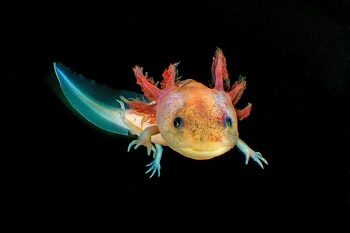 The number of gills is six – three on each side of the head – covered with fleshy terminations, in the form of long, thin wires, which increase the surface for gas exchange.
The number of gills is six – three on each side of the head – covered with fleshy terminations, in the form of long, thin wires, which increase the surface for gas exchange.
The axolotl has its body long, thin and dark and its legs short, the front ones having four fingers and the rear ones five. Albino specimens have also been recorded, but they do not live in the wild, being raised only in captivity.
The Axolotl salamander is inactive during the day, resting on the bottom with the gills extended. It moves very slowly and can occasionally get out to the surface of the water to get a “breath of air”. The axolotl is mainly hunted by herns.
Ambystoma Mexicanum species is used a lot in scientific research, due to its ability to regenerate the most affected parts of the body, its ease of reproducing, and the high number of embryos.
Although it may remain in the larvae form throughout its life, the Axolotl can metamorphosis in a fully developed adult salamander, in case the habitat or aquatic life is altered (e.g., water runs dry).
Moreover, in case it is injured, it does not scar its tissue, but rather the affected tissue area is transformed into cells similar to stem cells, which means that the Axolotl salamander is capable of reconstructing all its members or parts of its body.
Housing the Axolotl
For aquarium enthusiasts, it is well known that the water temperature for the Mexican salamander is 12 to 20 g Celsius, preferably 17-18 degrees (63-64 Fahrenheit). Higher temperatures lead to higher stress and appetite.
Water parameters:
- Acidity (pH) – 7-8;
- Hardness (dH) – 6-16º;
- Water temperature: 17-18 ° C;
- The volume of the aquarium: From 50 L;
- Behavior: Calm, sedentary.
The size of the aquarium
A single specimen of the Mexican Walking Fish needs a minimum aquarium of 50L with a minimum depth of 15-20cm. Considering that this is the minimum for surviving you should book him a larger space to develop normally and be able to walk freely. It is a creature that spends most of its time at the bottom of the aquarium.
Check out the terrarium you would need for a tarantula.
Adult salamanders need a larger volume – 100 liters. If you want to have more Axolotl, then the aquarium should contain 50-80 liters of water for each of them. The aquarium décor should not have sharp corners and edges – they can hurt your pet. Also, give it the appropriate amount of coverage.
Water quality
The purification of the aquarium water for these amazing animals is different from that of fish in the aquarium. To do this, you will need a powerful filter and a slow flow of water. An internal filter with a built-in towel is best because it is strong enough and does not generate a high current.
How often do you need to change the water? Axolotl care involves partial water changes every week. Since it consumes protein-rich foods, it is quite sensitive to the cleanliness of the aquarium. Therefore, you must remove food residues in time, and not overfeed it, so that excess food won’t float in the water and contaminate it.
The aquarium soils
Another important condition for keeping an Axolotl is the substrate in the aquarium. Most often, aquarium lovers choose the color, shape, and size of the substrate according to their own preferences. But for the axolotl, this factor is particularly important. If there is no substrate in the aquarium, the pet will feel very uncomfortable. This is stressful and can even lead to wounds on the tips of its feet.
Gravel is also not suitable as the animal can swallow it. This will cause the digestive tract to become blocked and in time lead to the salamander’s death. The best option is believed to be sand. This material allows the axolotl to move freely along the bottom.
The substrate can be formed from sand and that is perfect for the salamanders, but there are also chances that they will swallow it and suffer digestive problems that can lead to death. For safety reasons it is a good idea to have a stone substrate, larger than their head so that they won’t be able to swallow them.
Reproduction
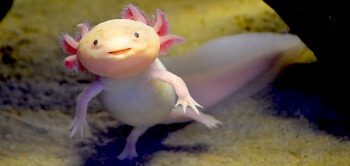 Although it remains in the larvae stage all its life, the Axolotl reaches sexual maturity between 12 and 18 months. Before mating, males court the females, “dancing” in front of them and swallowing them.
Although it remains in the larvae stage all its life, the Axolotl reaches sexual maturity between 12 and 18 months. Before mating, males court the females, “dancing” in front of them and swallowing them.
After this ritual, they put among the stones and aquatic plants the so-called spermatophores – the cone-shaped packs, which are taken over by the females for the internal fertilization of eggs.
They will deposit the fertilized eggs 24 hours later, wrapped in mucus so that they are stuck together. Incubation lasts two to three weeks.
One female can produce up to 400 eggs per day, the average being approximately 200.
Care requirements
Keeping such an exotic animal at home does not come with great difficulties, but there are things on which the length of their life depends. The main need is the water temperature. Axolotl is a cold-blooded creature, so warm water is a great stress-inducer for it.
It seems strange that animals with a Mexico-origin do not tolerate heat. The explanation is quite simple. The reason is that the axolotl’s habitat is usually high, where it is much colder than in the rest of the country. Future owners of this type of salamander must know that the temperature of the water that exceeds +24 degrees becomes inappropriate. If the axolotl stays in water at this temperature for a long time, it can become ill and even die. The most suitable temperature is considered to be less than 20 degrees. If you are not sure that you can create the necessary conditions for an axolotl, it is better not to buy one.
Food
The Mexican Salamander, Axolotl, is carnivora. It feeds on insects, worms, or small fish in the wild.
They locate the food by smell and salt, and then, any potential prey is sucked with force creating a sort of vacuum until the prey reaches the stomach.
Also, check out what frogs eat.
In captivity, they feed on several types of food: Trout, salmon, frozen or alive worms, some types of earthworms, and waxworms.
Young specimens feed on algae, while adults consume aquatic invertebrates.
Axolotl does not need a wide variety of foods. The main thing to remember is that this is a predator that needs a protein-rich diet.
The type and amount of food depend on the individual’s preferences. For example, diving foods designed for predators are great and come in the form of tablets or pellets. In addition, the lizards can also be fed such foods.
You can feed Axolotls with crushed worms; shrimp meat; frozen products; mussel meat; alive fish. Be careful with the latter option, as fish may be a source of infection, where Ambystoma’s larvae are very prone.
There are no special feeding rules. They are the same as for fish – it is not allowed to leave pieces of food in the aquarium, as protein food rots and immediately pollutes water. There is also no need to use mammal meat as food: Axolotl is not able to digest this type of food.
Price
The cost of such an extraordinary pet depends on several factors – age, color (light axolotls are more expensive), length. In the USA, the animal can be purchased from $20 up to $70 on average.
There are many animals considered rare in this world. One of the rarest animals is the Axolotl.
Mexican Axolotl is certainly not a pet for beginners. If you have never kept aquatic pets, it is highly recommended NOT to start with the Axolotl.
Although it may need more care and attention than other aquatic species, these unique and nice animals can be excellent pets and become loved family members.
